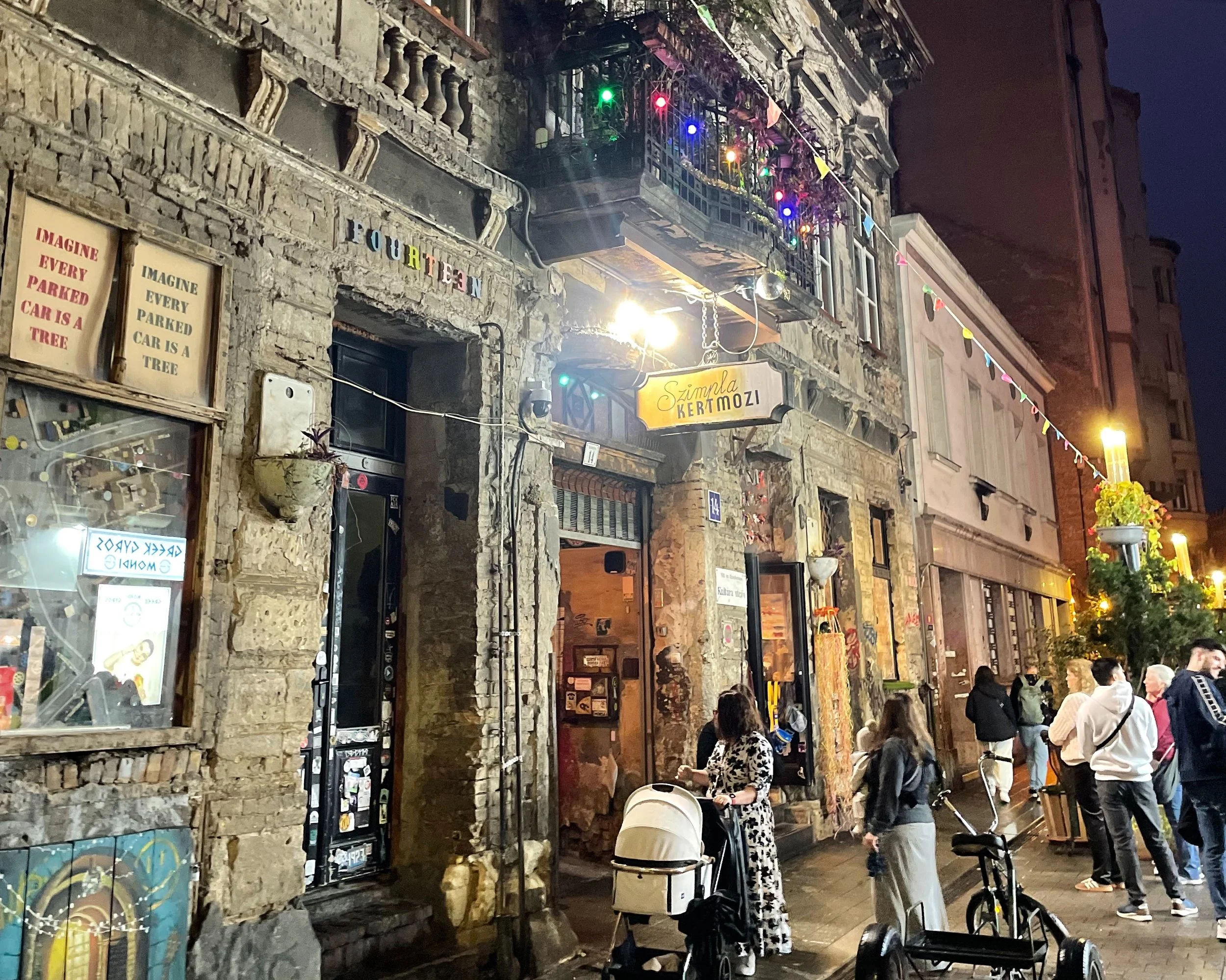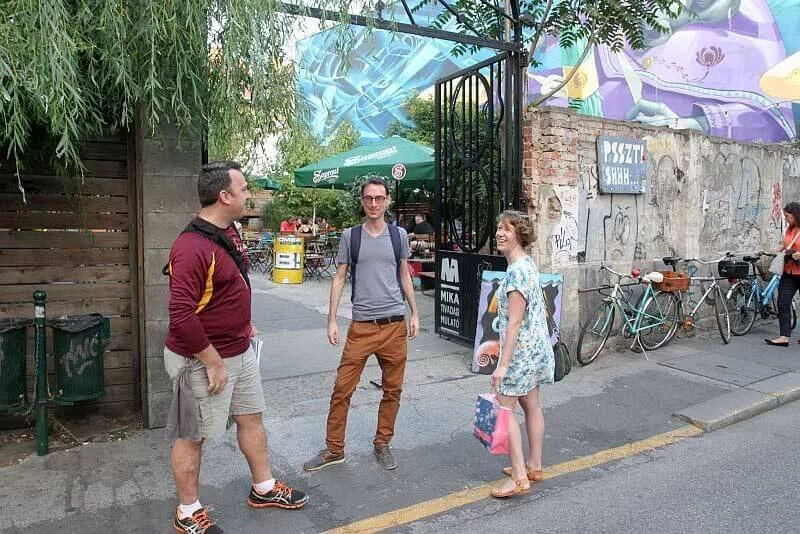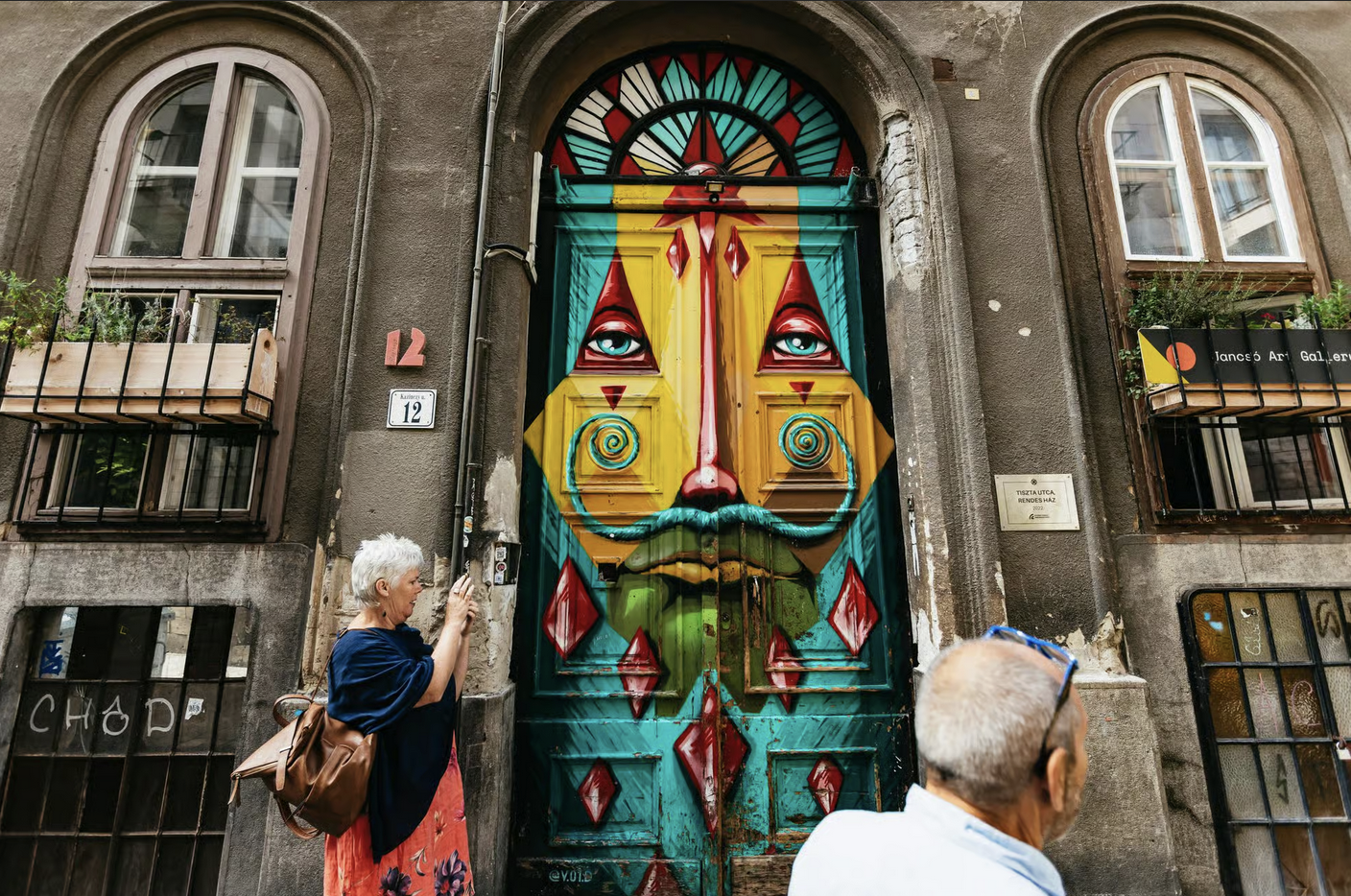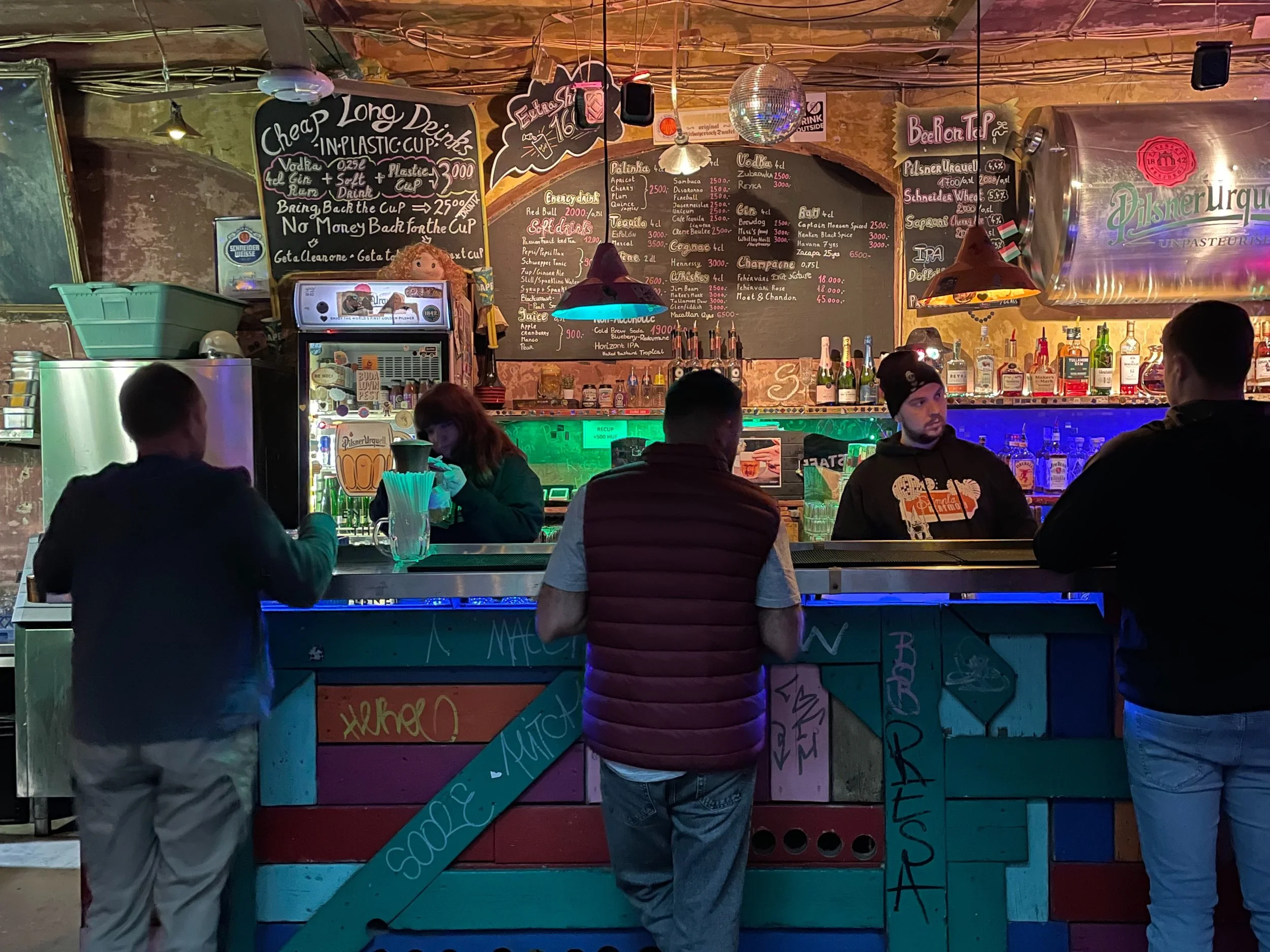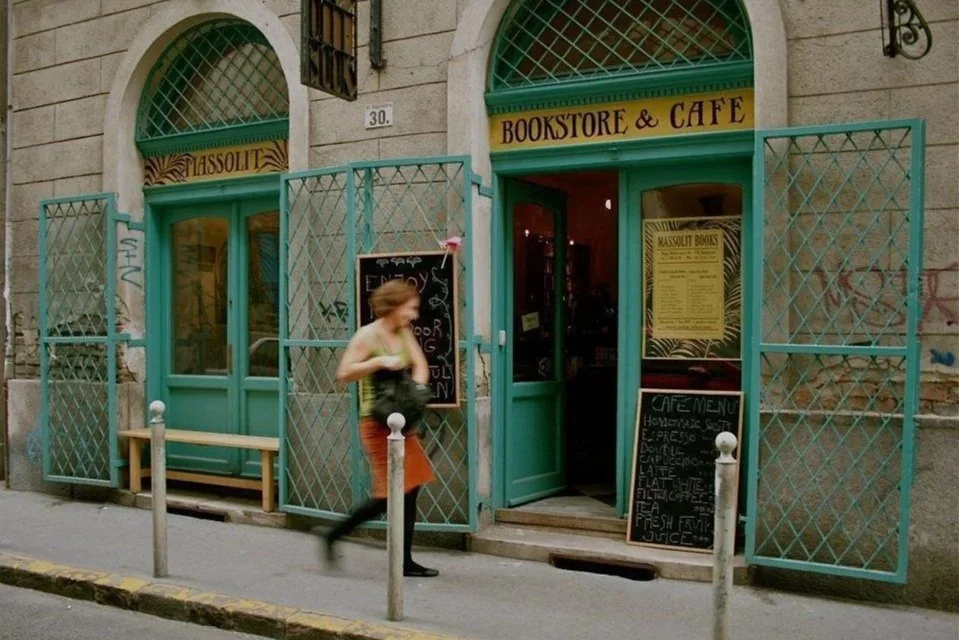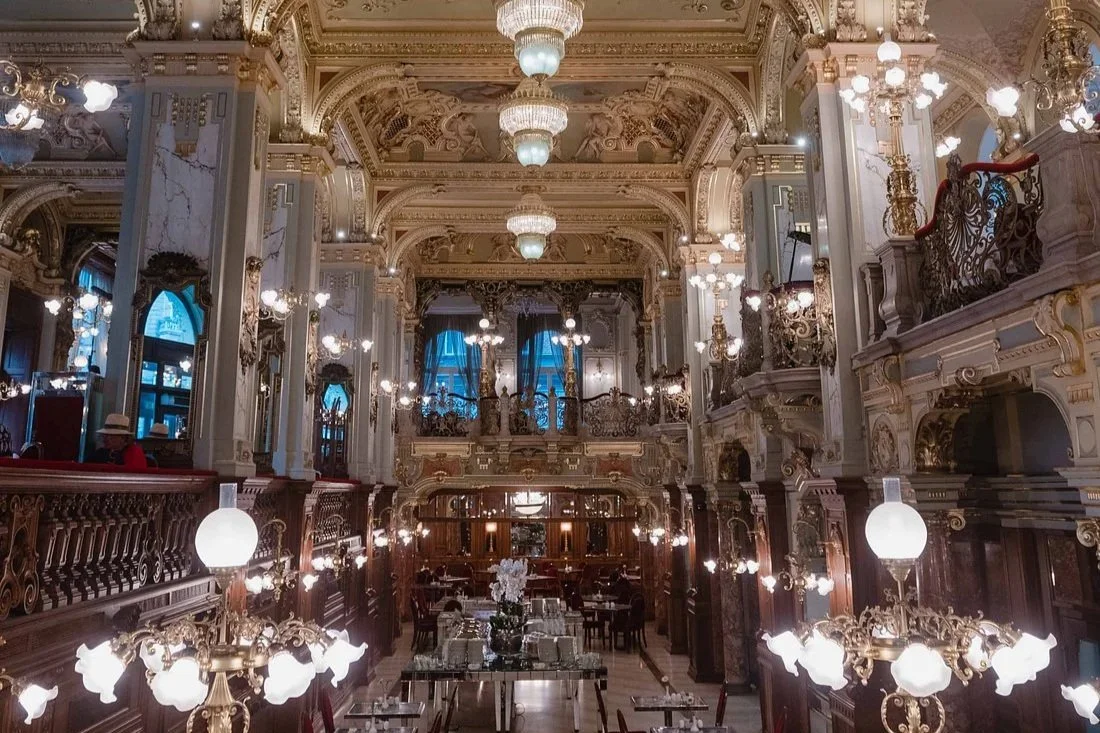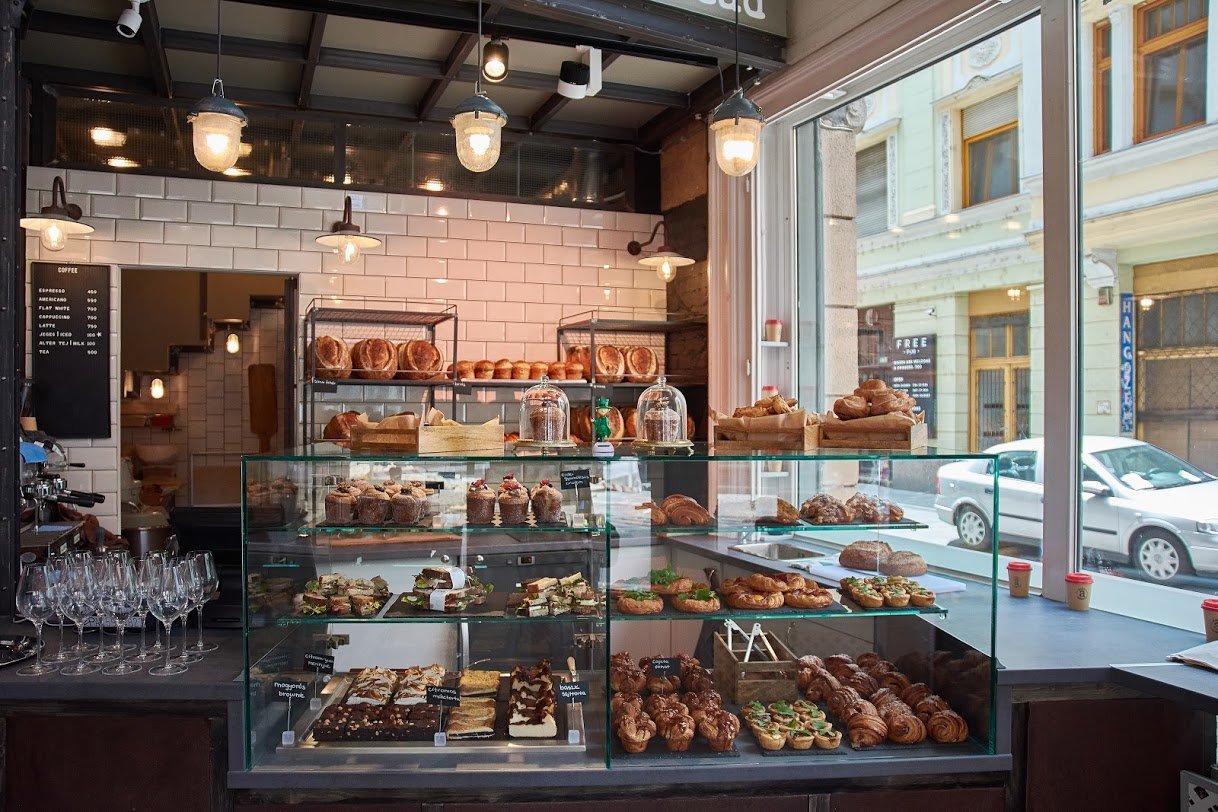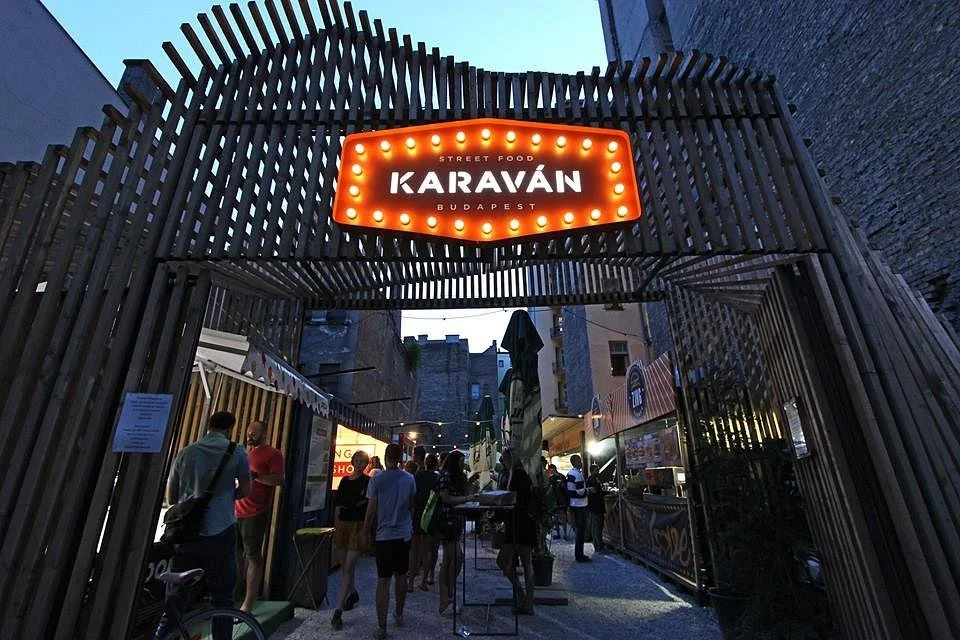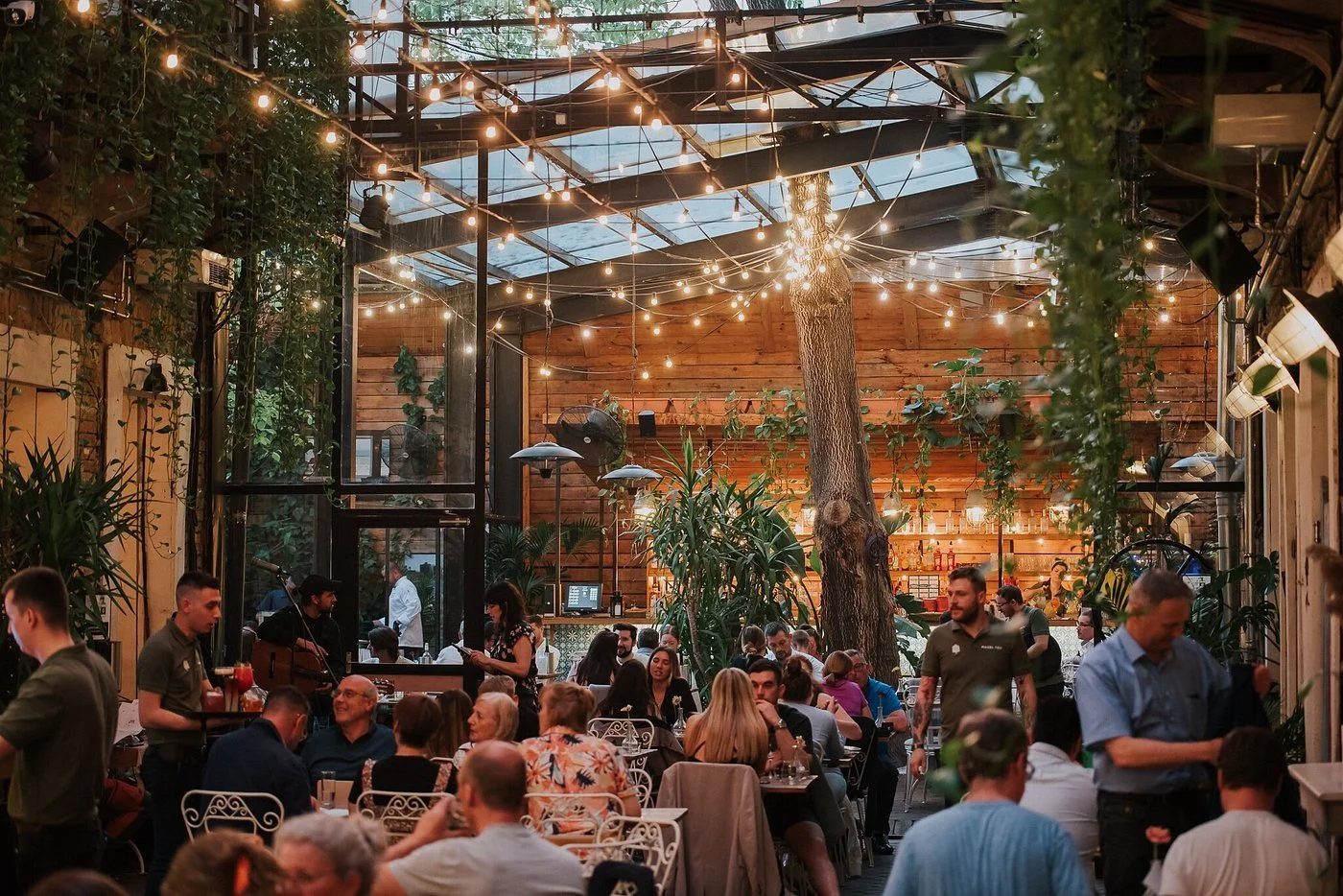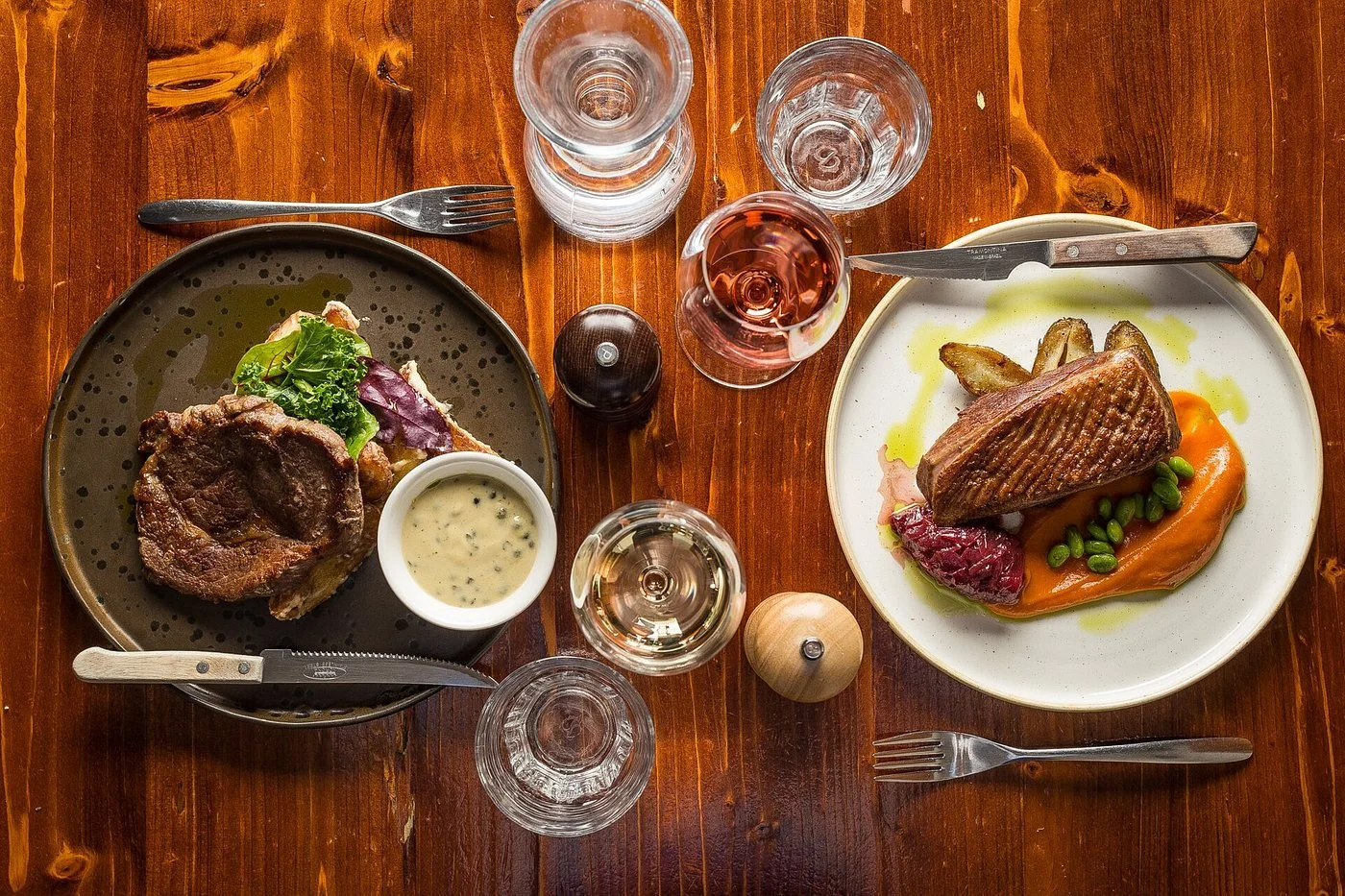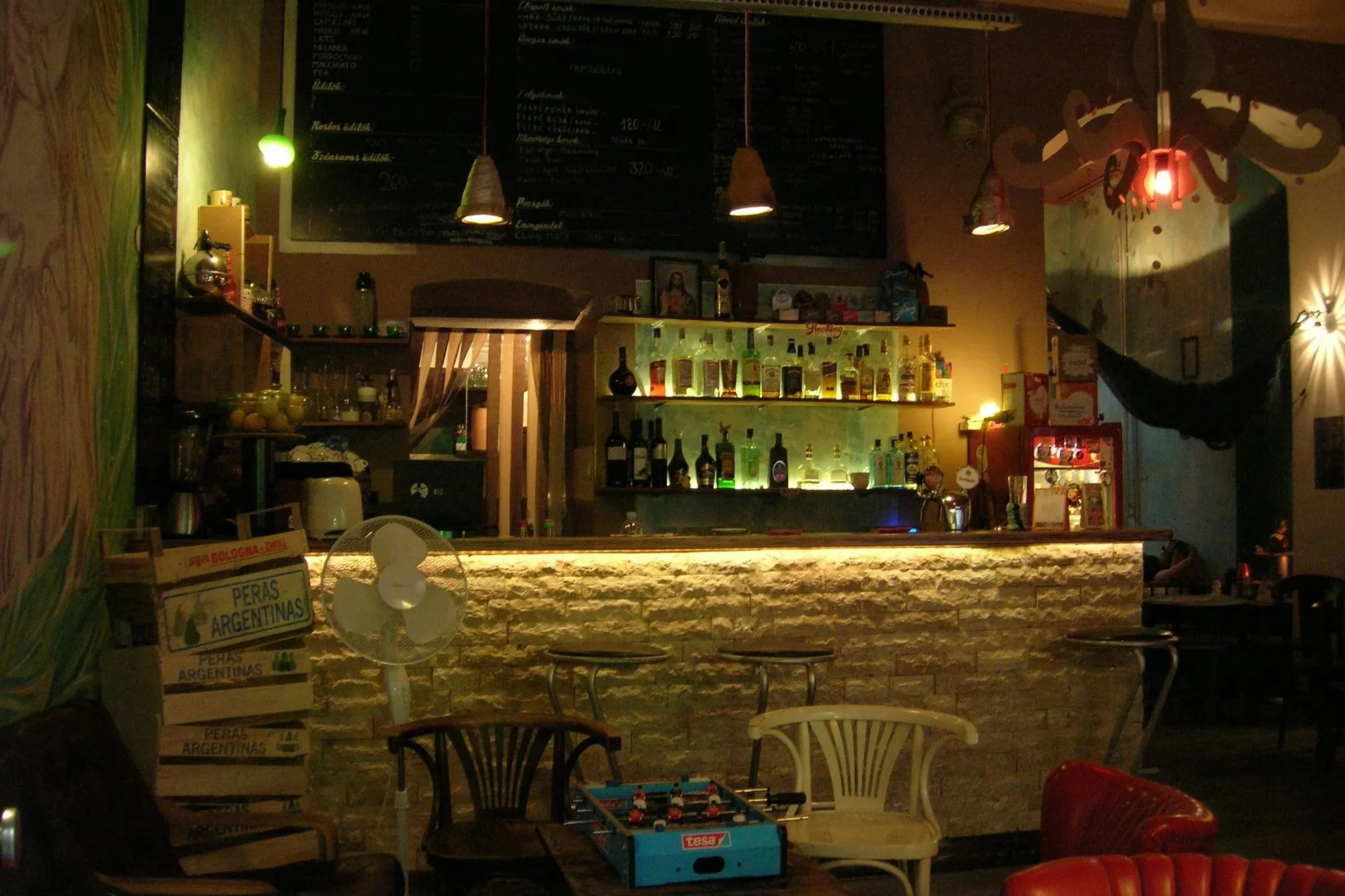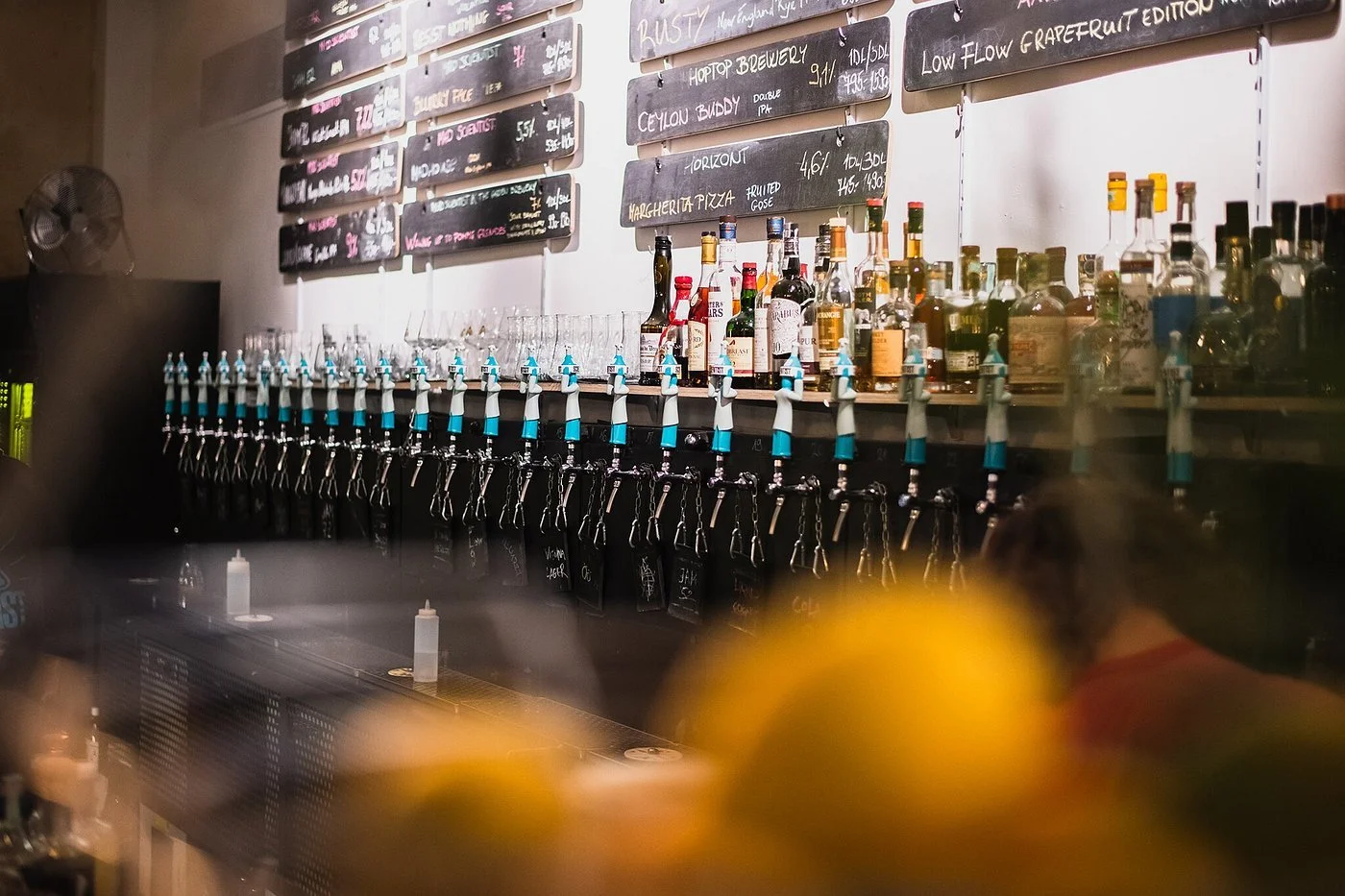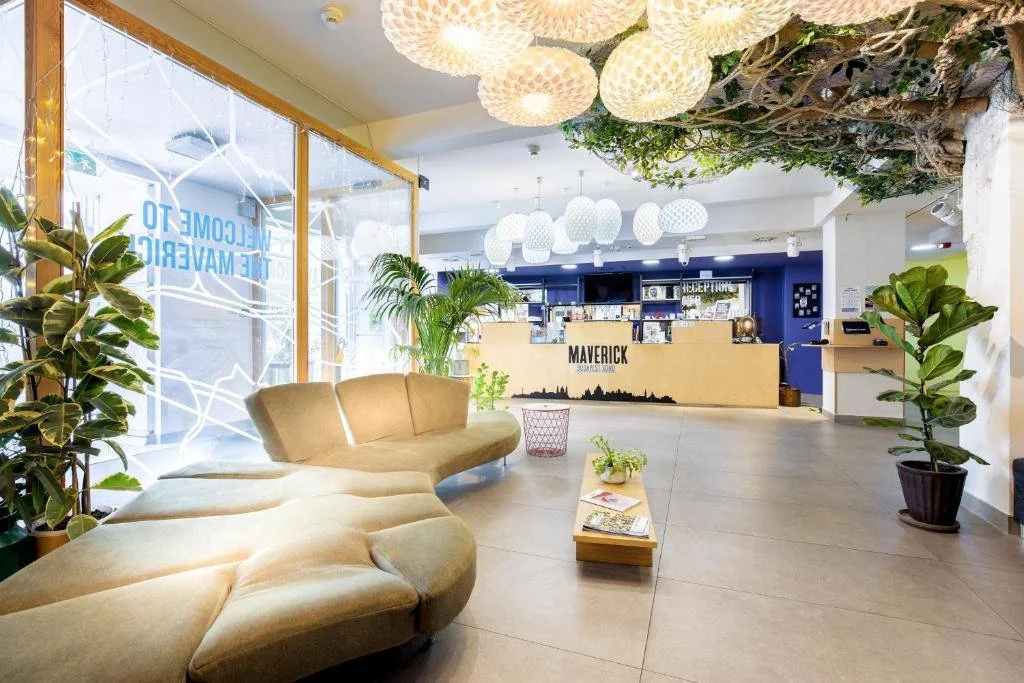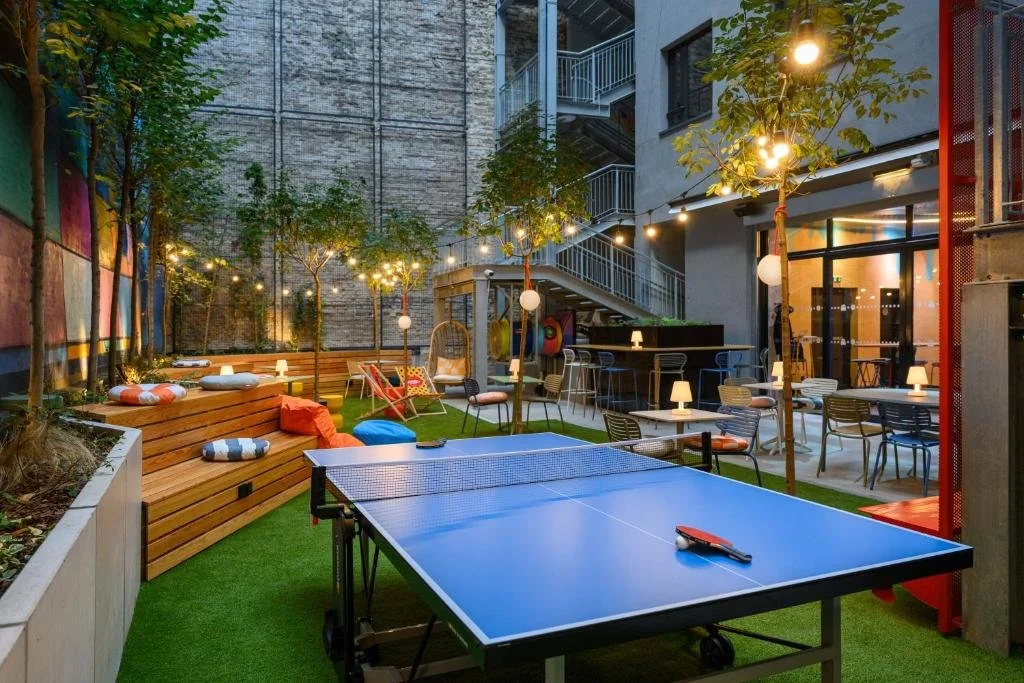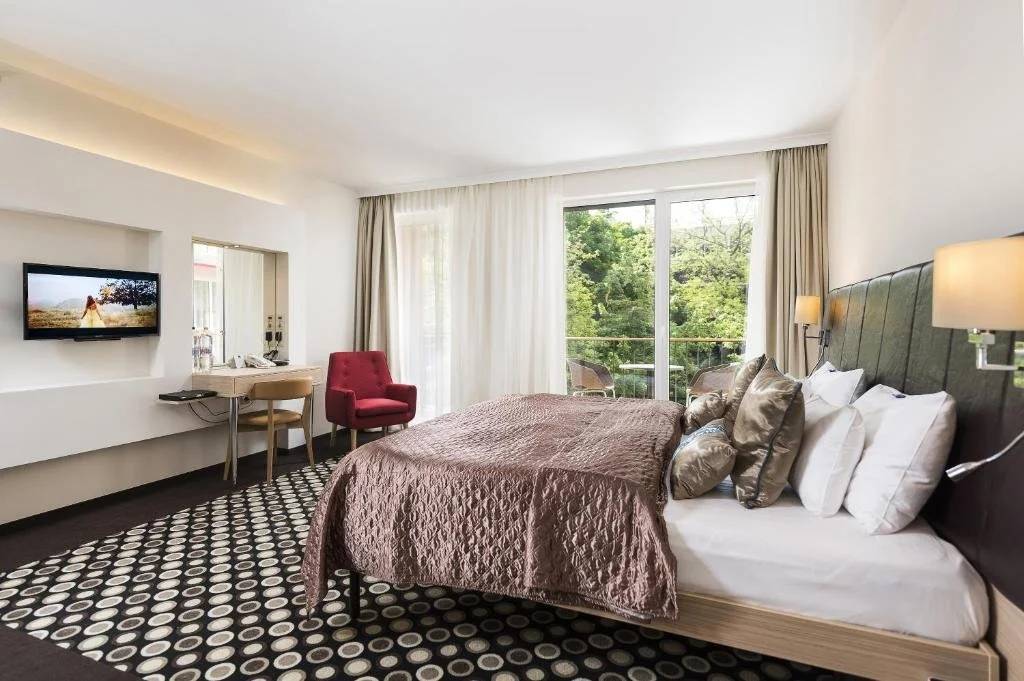The Ultimate Guide to Budapest’s Jewish Quarter (District VII) — Eat, See, Stay + Historical Context
This article may contain affiliate links. This means if you click a link on my blog and make a purchase, I may earn a commission at no additional cost to you.
There’s more to Budapest’s Jewish Quarter than ruin bars and synagogues. In this guide to District VII, I’ll take you deeper into this fascinating neighborhood, from its street art and local lunch spots to powerful memorials and local-led tours that bring this district’s past and present to life.
The Jewish Quarter, tucked inside Budapest’s District VII, was the district I kept coming back to during my recent visit to Budapest. It’s where all of the best restaurants seemed to be, the best nightlife, and, of course, powerful memorials and monuments to Jewish culture and history. By day, it’s a splash of color, with street art brightening the crumbling WWII and Communist-era facades. Its parks and patios are as good for books as for brunch, while its boutiques, both hotels and shops, give away the creativity coursing through its ongoing revitalization. It’s a neighborhood that draws you in with its ruin bar and restaurant allure, but that holds a history that will never get painted over or lost in the buzz of its nightlife and flea markets. Ready to meet it?
Quick Picks:
Must-see: Dohány Street Synagogue • Rumbach Synagogue • Street art on Akácfa, Kazinczy, and Dob
Best Ruin Bars: Szimpla Kert (iconic) • Mazel Tov (life music)
Essential Food Stops: Gettó Gulyás • Dobrumba • Karaván Street Food Hall
Top Tours: Jewish Heritage Tour • Budapest Flow’s Street Art Tour
Best Weekend Market: Szimpla Kert’s Sunday Farmer’s Market
Where to Stay: Roombach Hotel or Jo&Joe Budapest for something more social
Good To Know: District VII mixes nightlife with deep history—early or weekday visits offer quieter, more reflective wandering.
Table of Contents
Use the links below to jump to any part of this guide:
What's the history of Budapest's Jewish Quarter?
With roots stretching back to the late 18th and 19th centuries, Budapest’s Jewish Quarter grew out of both necessity and opportunity. Jewish residents—once restricted by residence laws and communal rules—settled in Pest’s bustling inner city, particularly in what is now District VII or Erzsébetváros.
Close to the commercial heart of the city and gradually freed from some restrictions during the Austro-Hungarian reforms, the neighborhood became a thriving hub of Jewish life. Homes, schools, kosher butcheries, and synagogues rose in dense rows, while merchants, craftsmen, and scholars flourished. Today, the façades of Neoclassical and Art Nouveau buildings still whisper of that vibrant community that once called these streets home.
That vitality was brutally shattered during World War II. In November 1944, tens of thousands of Jews were confined to the Pest Ghetto within District VII by the Nazi-backed Arrow Cross regime. Conditions were appalling: overcrowding, starvation, and disease were rampant, and many residents were deported to concentration and labor camps, including Auschwitz. At its peak, roughly 70,000 Jews lived in the ghetto, though countless others had already been sent away.
The ghetto stood until the Soviet Red Army arrived in January 1945, ending the Arrow Cross’s control and freeing survivors who found themselves in a landscape of desecrated synagogues, destroyed homes, and one of Europe’s major Jewish centers left in ruins. Today, memorials like the Holocaust Memorial Center, the Shoes on the Danube Bank, and the Raoul Wallenberg Memorial Park serve as quiet, powerful reminders of these events.
After the war, Budapest’s Jewish Quarter fell into decades of quiet neglect under Communist rule. Many buildings stood empty, and the neighborhood’s social fabric changed. But starting in the late 1980s, and especially through the 1990s and 2000s, the Jewish Quarter began to awaken again: synagogues were restored, galleries opened, artists started moving in, and abandoned courtyards transformed into cafés, shops, and the ruin bars that would eventually make the area world-famous. Today, it’s a neighborhood where memory and modern life coexist, inviting you to wander, stay curious, and see what you find.
Learn Before You Go (or After)
To truly understand Budapest’s Jewish Quarter, it helps to see beyond what’s in front of you. These resources will help you go deeper into the Jewish Quarter’s story:
Books
The Invisible Bridge by Julie Orringer: A sweeping novel that brings pre-war Budapest vividly to life through one family’s story of love, art, and loss.
Fatelessness by Imre Kertész: A Nobel Prize–winning, semi-autobiographical account of a Hungarian boy’s survival during the Holocaust, written with devastating simplicity.
Jewish Budapest: Monuments, Rites, History by Kinga Frojimovics et al.: The definitive nonfiction guide to the city’s Jewish history and cultural heritage.
Budapest: A History of Grandeur and Catastrophe by Joe Hajdu: Offers accessible historical context for understanding how the Jewish Quarter fits into the city’s larger story.
Films & Documentaries
Son of Saul (2015): Oscar-winning Hungarian film set in Auschwitz, offering a visceral perspective from a Hungarian-Jewish prisoner.
1945 (2017): A quiet, powerful post-war drama about guilt, memory, and the return of Jewish survivors to a Hungarian village.
Torn from the Flag (2007): A Hungarian documentary exploring both the Holocaust and Hungary’s 1956 revolution through personal narratives.
Parts Unknown with Anthony Bourdain (2015): In Bourdain’s Budapest episode (S5 E4) he explores the beauty, culture, and food of Budapest.
What is Budapest's Jewish Quarter like today?
Today, the Jewish Quarter is a place where memory, identity, and reinvention overlap, shaping a neighborhood that feels both historic and vibrantly present. Understanding its layered history will change how you experience it. Beyond its historic landmarks, the neighborhood hums with daily life—parents walking children to school, neighbors chatting in sunlit courtyards, and artisans opening small shops that reflect the area’s creative energy. It draws artists, students, and entrepreneurs while honoring centuries of Jewish heritage.
Since the 1980s, restored synagogues, galleries, and theaters have revived these streets, while street murals and small exhibitions celebrate both Jewish tradition and contemporary culture. The district’s cafés and bars double as cultural hubs, hosting live music, art shows, and informal discussions and the Quarter’s famous ruin bars—eclectic, artsy spaces repurposed from abandoned buildings—blend history with nightlife.
As I mentioned, the Jewish Quarter’s restaurant game is strong and reflects the same duality of memory and reinvention. Beyond classic Hungarian and Jewish dishes, modern cafés, artisanal bakeries, and farmers’ markets provide a window into everyday life in the Jewish Quarter of today. A coffee and strudel, a stroll through Szimpla’s Sunday market, or a meal at a family-run eatery or kosher deli will give you that tangible connection to this special neighborhood’s rhythms.
Tours that Bring the Jewish Quarter to Life
If I haven’t already made this clear, exploring Budapest’s Jewish Quarter is far more rewarding when you go beyond the surface. Here are six carefully curated tours that will take you that extra layer deeper into the Jewish Quarter’s past and present:
Budapest Flow’s Ruin Pubs, Street Art, and Cool Spots Tour
This early-evening tour by Budapest Flow takes you through the district’s history—from its bustling pre-war streets to the WWII ghetto and its modern-day creative revival. You’ll hop between some of the best ruin bars, spot striking street art, and peek into local galleries and design shops. It’s part history lesson, part nightlife stroll, and a great way to feel the neighborhood’s energy firsthand.
Tour Info & Booking:
Duration: ~3 hours
Time: Every Thursday at 4 pm
Price: 45 euros per person (includes one beer, wine, or coffee)
GetYourGuide: Jewish Heritage Walking Tour
This guided walk takes you through the District VII’s Jewish-centered streets and stories. See the grandeur of the Dohány Street Synagogue and the Rumbach Street Synagogue, explore the Jewish Museum with its Holocaust memorial, and visit the Martyrs’ Cemetery, Raoul Wallenberg Memorial Park, and Heroes’ Temple. By the end, you’ll understand more about the neighborhood’s history, resilience, and enduring cultural spirit—without feeling like you’re just checking off sites.
Tour Info & Booking:
Duration: option for a 2-hour or 4-hour tour
Time: Every Sunday, Monday, Thursday, & Friday at 10 am
Price: from $68 per person (includes skip-the-line entry to museums and synagogues on the itinerary)
Budget Tip: If this experience is out of your price range, check out GuruWalk’s tip-based Jewish Quarter free walking tours—they’re free to join. Simply tip your guide what you can at the end.
GetYourGuide: Jewish Quarter Food Tour (Drinks Included)
Explore District VII through its flavors on this guided tasting tour through the Jewish Quarter. Sample Hungarian street food like Lángos, traditional dishes like nokedli dumplings, and Jewish-Hungarian pastries such as Flódni, paired with local drinks like Pálinka and Tokaji wine. Along the way, you’ll hear stories from locals and learn how food connects to the neighborhood’s history and culture, leaving you with a full-sensory view of the Jewish Quarter beyond just sightseeing.
Tour Info & Booking:
Duration: ~3 hours
Time: Daily at 12 pm and 6 pm
Price: from $68 per person (includes all food + 3 alcoholic beverages)
Viator: Ruin Bars Evening Walking Tour (Drinks & Street Food Included)
Experience the Jewish Quarter after dark on this guided stroll through its iconic and hidden ruin bars. Sip local drinks, try small snacks, and take in the street art that animates District VII. Beyond the bars, you’ll get context on the neighborhood’s history, culture, and the rise of the ruin bar scene. It’s a lively way to feel the Quarter’s creative energy firsthand alongside a local.
Tour Info & Booking:
Duration: ~3 hours
Time: Daily at 6 pm
Price: from $175 per person (includes snacks and drinks)
GetYourGuide: Street Art and Underground Movements Walking Tour
Explore the Jewish Quarter’s murals and graffiti with a guide who shares the stories, techniques, and messages behind each piece. This street art tour goes beyond sightseeing, showing how street art reflects history, identity, and contemporary issues. This is perfect for anyone interested in Budapest’s and the Jewish Quarter’s creative underground.
Tour Info & Booking:
Duration: ~2 hours
Time: Daily at 10:30 am
Price: from $28 per person
Budapest Flow’s Sunday Morning Chill Tour
Experience the Jewish Quarter in daylight, when its famous ruin pubs turn into relaxed cafés and markets. Visit Szimpla Kert’s Sunday farmers’ market, sip coffee at a top local café, discover street art, and sample street food. Hidden courtyards and serene gardens give a quieter perspective on a neighborhood usually known for nightlife on this Sunday Morning Chill Tour by Budapest Flow.
Tour Info & Booking:
Duration: ~3 hours
Time: Every Sunday at 10 am
Price: 45 euros per person (includes one coffee, lemonade, or beer)
If none of these tours quite match your vibe, there are plenty more ways to explore Budapest’s Jewish Quarter. Check out additional experiences, guided walks, and insider activities on Viator, GetYourGuide, GuruWalk, and TripAdvisor. Booking through these links helps support the blog at no additional cost to you. Thank you!
Things to Do & See in Budapest's Jewish Quarter
Dive Into the Jewish Quarter’s Ruin Bar Scene
No visit to Budapest’s Jewish Quarter is complete without a night among its famous ruin bars. What began as an underground movement in abandoned buildings is now a defining part of the city’s identity. Explore Szimpla Kert, Instant-Fogas, and Mazel Tov—each offering a unique mix of art, music, and community. Along the way, you’ll notice smaller gems like Doboz or Kőleves, tucked into side streets, each with its own vibe and story. Whether you join a guided tour to learn each spot’s backstory, sign up for a pub crawl, or wander between bars on your own, you’ll feel the creative pulse that has redefined Budapest nightlife.
Travel Tip: Start early at Mazel Tov or Kőleves for dinner, then head to Szimpla or Instant-Fogas for the night
Curious about how it all began? Check out Budapest Flow’s post on the history of the ruin‑bar movement in Budapest.
Savor the Jewish Quarter’s Markets, Food Halls & Weekend Vibes
Budapest’s Jewish Quarter comes alive through its markets, food stalls, and weekend vibes that bring history and community to life. Start at Szimpla Kert on Sunday, where Budapest’s most famous ruin bar transforms into a bustling farmers’ market filled with fresh produce, pastries, and local specialties. Wander the Gozsdu Weekend Market for artisan crafts, vintage treasures, and a taste of local life, then wander through Klauzál Square Market Hall, a favorite spot for quick bites, fresh ingredients, and local flavors that also hosts the Antik Placc flea market every Sunday. If you’re not too full on food yet, finish at Karaván Street Food Court where a rotating lineup of food trucks serve lángos, Hungarian classics, and international dishes.
For a deeper dive, consider joining Budapest Flow’s Sunday Morning Chill Tour, which guides you through these markets while sharing stories about the Quarter’s history, culture, and creative scene. It’s the perfect way to taste the neighborhood while understanding the people and stories behind it.
Travel Tip: Bring cash for vendors, and come hungry—you’ll want to sample it all.
Details
Where: Szimpla Kert (Kazinczy u. 14), Gozsdu Courtyard (Király u. 13 / Dob u. 16), Karaván (Kazinczy u. 18)
Hours: Szimpla: Sun 9 am to 2 pm | Gozsdu: Fri–Mon 10 am to 5 pm | Klauzál: Daily 7 am to 5 pm | Karaván: Daily (varies)
Spot the District’s Street Art & Murals
Walls speak in District VII. Across the Jewish Quarter, vibrant murals, stencils, and wheat-paste posters bring the city’s history, culture, and social commentary to life. Large-scale murals often reimagine Jewish heritage and the neighborhood’s pre- and post-war identity, while smaller pieces reflect contemporary issues like migration, resilience, urban change, even by way of Communist-era cartoons in miniature frames. Streets like Akácfa, Kazinczy, and Dob showcase a constantly shifting outdoor gallery where every corner tells a story—from local legends to international collaborations.
Travel Tip: For deeper context, join a guided experience—either a dedicated street art tour or Budapest Flow’s combined street art tour and hands-on graffiti workshop.
Explore Jewish Heritage & Memorial Sites
The Jewish Quarter is obviously full of Jewish history and culture and you can feel it at every corner. Start at the Dohány Street Synagogue, Europe’s largest, where the ornate Moorish Revival architecture frames centuries of Jewish life. Step inside the Jewish Museum to see ritual objects, art, and stories of survival, then wander the Raoul Wallenberg Memorial Park and the Tree of Life sculpture, whose silver leaves bear the names of Holocaust victims. Next, pause at the Heroes’ Temple, a serene space honoring Jewish soldiers lost in World War I.
Just a short walk away, the Rumbach Street Synagogue awaits—a beautifully restored hidden gem hosting exhibitions and concerts. Outside, as you continue to explore, don’t miss the surviving ghetto wall on Király Street, a fragment of the barriers that once trapped tens of thousands in 1944-45, and keep an eye on the ground demarcators scattered through the Quarter marking the original ghetto boundaries as well as the stumbling stones that point out where the victims of the Holocaust lived before they were deported. Finally, venture outside the Quarter to visit the Shoes on the Danube Bank, where 60 pairs of iron shoes commemorate the Jews executed along the river during WWII.
Travel Tip: For a deeper dive, join a guided Jewish Heritage walking tour that takes you inside these synagogues and sites, or try GuruWalk’s free, tip-based tours through the Quarter for a budget-friendly way to explore the neighborhood’s Jewish history.
Details
Hours: Most sites open 10 am to 5 pm
Tickets: Dohány Synagogue ~3,000 HUF (includes entry to Jewish Museum, Raoul Wallenberg Memorial Park & Tree of Life, and Heroes’ Temple); Rumbach Street Synagogue~2,000 HUF; Shoes on the Danube free
Discover the Quarter’s Local Art, Vintage Shops & Bookshop Cafe Culture
Step off Kazinczy or Király Street and you’ll find another side to the Jewish Quarter—quieter, creative, and full of stories. The same courtyards that once held tailors and kosher butchers now house independent galleries, design shops, and bookstores that give the neighborhood its modern pulse.
Pop into Printa, a sustainable design studio and gallery where screen-printed posters and textiles celebrate urban life in Budapest. Around the corner, INDA Gallery showcases some of Hungary’s most exciting contemporary artists, while Massolit Books & Café remains a beloved refuge for books, coffee, and calm—part English-language bookstore, part time capsule of the Jewish Quarter’s bohemian spirit.
For vintage and design lovers, Szputnyik Shop mixes retro finds with modern Hungarian streetwear, and Retrock nearby is a treasure chest of reworked vintage fashion. Don’t miss Judapest either, a witty design shop blending Jewish and Hungarian identity into clever gifts and locally made jewelry, a nod to the neighborhood’s layered past and present.
Eat Your Way Through the Jewish Quarter
If you want to understand Budapest’s Jewish Quarter, start with your fork. This neighborhood tells a pretty good story through food—from Sabbath stews and flaky pastries to street snacks served from old courtyards. Grab a golden, garlic-brushed lángos at Karaván Street Food Court, then satisfy your sweet tooth with a slice of flódni—the layered apple, walnut, poppy seed, and plum jam pastry symbolic of Jewish Budapest—at Auguszt Cukrászda.
For a sit-down meal, Gettó Gulyás serves paprika-rich goulash and other Hungarian classics, while Carmel Étkezde remains the go-to for kosher cholent, the hearty Sabbath stew. Morning people should make a beeline for Arán Bakery, where sourdough loaves and cardamom buns fly off the shelves.
Pair it all with a glass of Tokaji or a shot of pálinka at Doblo Wine Bar, and you’ll taste the full spectrum of this neighborhood—tradition, reinvention, and everyday life, all on one plate.
Travel Tip: For a deeper dive, join a food tour through the Jewish Quarter to sample local dishes while hearing the stories behind them.
Wander Without a Plan
The best way to feel Budapest’s Jewish Quarter is by letting your feet and your own curiosity lead the way. Lose yourself in the maze of the Jewish Quarter’s narrow streets, stumble into its sunlit courtyards, peek inside whichever cafés and vintage shops catch your eye, and let chance encounters shape your experience. Each turn offers something new to discover—from grand synagogues to tucked-away murals and leafy parks—blending the sacred and the everyday, the old and the new, loss and revival.
If you like a little structure without giving up freedom, the GPSmyCity app offers a self-guided walking route through the Jewish Quarter, highlighting key sites and their backstory while leaving plenty of room for the detours, spontaneous discoveries, and moments of curiosity this travel blog is all about.
Where to Eat & Drink in Budapest's Jewish Quarter
Budapest’s Jewish Quarter is one of the city’s best places to eat—a neighborhood where Jewish heritage meets global flavors, and where ruin bars double as gardens, cafés, farmer’s markets, and art spaces. From brunch spots and bakeries to courtyard bistros and craft beer hangouts, here’s where to taste the Jewish Quarter’s culinary spirit.
Breakfast, Brunch, & Coffee
Perfect for: slow mornings, quiet reading, and homemade cake in a leafy courtyard
Part café, part bookstore, part sanctuary. Shelves of English and Hungarian books (new and secondhand) line the walls, and the mismatched furniture and leafy courtyard out back make it feel like a secret garden for readers. Come for the coffee and homemade cakes, stay to browse local authors like Magda Szabó and Péter Nádas or just to linger somewhere time seems to slow down.
Location: Nagy Diófa u. 30
Hours: open daily 9:30 am to 7 pm
Perfect for: decadent desserts, gilded ceilings, and a taste of old-world Budapest glamour
Often called “the most beautiful café in the world,” New York Café is where Budapest’s golden age of art and coffeehouse culture still shines. Beneath frescoed ceilings and glittering chandeliers, writers once lingered over espressos and debate in its Belle Époque interiors. Go for the opulence (with $15 cappucinos to match), stay for the people-watching and the live piano.
Location: Erzsébet krt. 9-11
Hours: open daily 7 am to 12 am
Perfect for: slow brunches, design lovers, and a laid-back creative buzz
A hybrid café and design shop, Vinyl & Wood nails the art of slow mornings. Locals linger over avocado toast, eggs benedict, and perfectly pulled espressos while browsing the in-house lifestyle store filled with prints, ceramics, and homewares by Hungarian makers. The vibe is effortlessly cool—industrial touches softened by greenery and sunlight streaming through big windows.
Location: Wesselényi utca 23
Hours: open daily 8 am to 5 pm
Perfect for: breakfast, third-wave coffee, and slow mornings.
Dorado pairs sleek, minimalist design with expertly brewed coffee, earning a loyal local following. Their breakfast menu includes eggs, pastries, and light seasonal dishes, making it a top pick for a relaxed morning or a laptop session. Locals swear by their espresso and cappuccino, while the calm interior and leafy outdoor seating offer a rare pause in the bustling Jewish Quarter.
Location: Klauzál u. 35
Hours: M-F 8:30 am to 5 pm; Sat 9 am to 5 pm; Sun 9 am to 3 pm
Perfect for: artisanal pastries, sourdough, and lingering over coffee
Arán Bakery is the kind of place you stumble into and immediately want to stay awhile. Founded by an Irish-Hungarian couple, it’s all about daily-baked sourdough, flaky pastries, and seasonal sandwiches made from local ingredients. The coffee is top-notch, too—smooth, carefully brewed, and the perfect companion to whatever treat you pick. Cozy, unpretentious, and full of warmth, it’s a spot to slow down and soak in a little slice of Budapest life.
Location: Wesselényi u. 23
Hours: open daily (M-F: 7:30 am to 7 pm; Sat & Sun: 8 am to 3 pm)
Lunch, Dinner, & Street Food
Perfect for: hearty Hungarian classics and generous portions
Gettó Gulyás is where locals go when they want reliable, comforting Hungarian food without fuss. The goulash here is a neighborhood legend, slow-cooked and generously seasoned with paprika, while the stews change seasonally with fresh, local ingredients. Come around lunchtime to see office workers and longtime residents sharing tables—a true taste of everyday Budapest life, beyond the tourist trail.
Location: Wesselényi u. 18
Hours: open daily 12 pm to 11 pm
Reservations Recommended (click here to reserve a table).
Perfect for: street food, casual bites, and people-watching
Karaván is the Jewish Quarter’s open-air foodie playground, right next to Szimpla Kert. Grab a Lángos dripping with garlic and cheese, a vegan burger, or a sweet chimney cake from the rotating lineup of food trucks, then settle in at one of the communal picnic tables. Locals swing by for a quick bite or an evening drink with friends, so take your time, soak up the courtyard energy, and sample bites from different trucks.
Location: Kazinczy u. 18
Hours: open daily 11:30 am to 12 am
Perfect for: Mediterranean-inspired plates, cocktails, and people-watching
Mazel Tov feels like the Jewish Quarter’s chic oasis inside of what’s technically a ruin bar. The menu is a fresh, modern take on Middle Eastern and Mediterranean flavors, perfect for sharing plates over long conversations. Locals swear by the lamb dishes and mezze, and the cocktail list is as vibrant as the décor. Grab a corner table and linger here.
Location: Akácfa u. 47
Hours: open daily (M-F: 12 pm to 11 pm; Sat & Sun: 12 pm to 12 am)
Reservations recommended (click here to reserve a table).
Perfect for: sharing plates, vibrant flavors, and a relaxed lunch or dinner
Dobrumba brings the Levant to Budapest with colorful, veggie-forward dishes that are made for sharing. The space is modern and minimalist, letting the food shine, from falafel and hummus to inventive salads and roasted vegetables. Locals love it for a casual midweek lunch or a laid-back evening with friends. Don’t miss the freshly baked flatbreads—perfect for scooping up every last bite—and the natural wine list.
Location: Dob u. 5
Hours: open daily 12 pm to 11:30 pm
Reservations recommended (click here to reserve a table).
Perfect for: casual meals, seasonal dishes, and soaking in courtyard vibes
Kőleves occupies a former kosher meat factory that’s part of the neighborhood’s original network of pre-war courtyards. Today, this ruin bar and restaurant provides a serene escape amid District VII’s energy. The menu celebrates seasonal Hungarian comfort food, including hearty stews, fresh salads, and daily specials made from local ingredients. By day, it’s this leafy garden serving Hungarian and Jewish-inspired comfort food; by night, it becomes more of a laid-back drinking spot.
Location: Kazinczy u. 37-4
Hours: Thurs-Sat 12 pm to 11 pm; Sun, Tues, & Wed 12 pm to 10 pm; closed Mondays
Bars & Late-Night Spots
Perfect for: casual drinks, laid-back nights, and local crowds
Literally “Black Dog,” Fekete Kutya is a longtime favorite for locals who want a relaxed spot away from the tourist-heavy ruin bars. Housed in a pre-war building that hints at the neighborhood’s layered history, it offers a simple but solid drinks menu—think classic cocktails, Hungarian spirits, and a few craft beers. The vibe is unpretentious and cozy, making it ideal for lingering into the late hours while watching the Jewish Quarter’s nightlife unfold around you.
Location: Dob u. 31
Hours: open daily 5 pm to 2 am
Perfect for: live music, DJs, and a true local ruin bar feel
DZZS Bar is one of those spots where locals actually go, giving it a genuine, unpolished charm. It’s small, a bit rough around the edges (as any dive bar should be), and full of character. DJs spin funk, soul, or electronic sets, and local bands often take the stage—making it a perfect stop for anyone looking to feel the creative pulse of Budapest’s nightlife beyond the usual tourist spots.
Location: Nagy Diófa u. 32
Hours: Mon to Sat 6 pm to 2:30 am; closed Sundays
Perfect for: craft beers, local taps, and laid-back late nights
Madhouse is a cozy, low-key bar in the heart of the Jewish Quarter, famous among locals for its rotating selection of craft beers on tap. The intimate space and relaxed vibe make it a favorite spot to unwind after a day of exploring or to hop between nearby ruin bars. Grab a pint, soak in the atmosphere, and enjoy a truly local taste of Budapest’s beer scene.
Location: Anker köz 1-3
Hours: open daily 12 pm to 2 am
Best Places to Stay in Budapest's Jewish Quarter
To really understand the Jewish Quarter, why not wake up inside it? Staying in this neighborhood means tracing history with your morning coffee, walking through courtyards that hold decades of stories, and sharing streets with locals who give this district its heartbeat. These stays, ranging from boutique hotels inside restored 19th-century buildings to design-led hostels and spacious family-friendly suites, will play you in the Jewish Quarter story.
Local Context (please read!)
While short-term rentals are plentiful in the Jewish Quarter, be aware that locals have raised concerns about noise, rising rents, and changes to the neighborhood’s character. As a result, I haven’t recommended any apartments or Airbnbs here.
If you opt for an apartment stay, consider choosing buildings that are part of managed, responsible rental programs and be mindful of quiet hours. Supporting hotels, hostels, and family-run guesthouses can help you enjoy the Quarter while respecting the community that calls it home.
For the Social Traveler: Best Hostels in Budapest’s Jewish Quarter
The Hive Party Hostel — Best Hostel for Nightlife in the Jewish Quarter
Dorms from $9 | Privates from $68
A lively base steps from Szimpla Kert, The Hive is built for nightlife lovers. Expect modern dorms with ensuite bathrooms, a rooftop bar, daily events, and a 24-hour reception. Perfect for solo travelers ready to meet new people and dive into the party scene.
Check Availability
Maverick Budapest Soho — Stylish Yet Social Hostel
Dorms from $15 | Privates from $48
Set inside a renovated historic building on Kazinczy Street, Maverick Soho is the grown-up answer to the party hostel. Clean, design-forward, and steps from ruin bars and street food spots, it’s ideal for travelers who want atmosphere without chaos. Guests love the shared kitchen and the friendly, community feel.
Check Availability
Jo&Joe Budapest — Trendy Hybrid Hostel Near the Synagogue
Dorms from $14 | Privates from $71
Next to the Dohány Street Synagogue, Jo&Joe mixes hostel energy with hotel comfort. Think colorful interiors, communal spaces, and a rooftop bar with killer city views. The vibe is young, urban, and creative—great for digital nomads or anyone who loves a social, stylish stay.
Check Availability
For Boutique Charm: Best Boutique Hotels in the Jewish Quarter
Roombach Hotel — Boutique Comfort by Gozsdu Udvar
Rooms from $101 | Breakfast included
This cheerful boutique hotel sits just off Király Street, perfectly positioned between the Jewish Quarter’s ruin pubs and Deák Ferenc Square. The rooms at Roombach Hotel are compact but stylish, breakfast is generous, and the staff get rave reviews for their warm hospitality—a sweet spot for couples or solo travelers who want walk-everywhere convenience.
Check Availability
Hotel Memories—Modern Stay Beside the Dohány Synagogue
Rooms from $95 | Breakfast included
A modern, mid-range hotel with perks like a 24-hour fitness room and complimentary breakfast, Hotel Memories sits right beside the Dohány Street Synagogue. It’s hard to beat the location—you’re in the cultural heart of the Jewish Quarter, surrounded by cafés, heritage sites, and transport links.
Check Availability
For Families: Best Family-Friendly Hotels in Budapest’s Jewish Quarter
Bo33 Hotel Family & Suites — Spacious and Kid-Friendly
Rooms from $135 | Breakfast & rooftop spa included
Tucked in a quieter pocket of District VII, Bo33 offers large family rooms, a rooftop jacuzzi with skyline views, and an excellent breakfast spread. It’s an ideal base for families or travelers who want walking access to the Quarter without the late-night noise.
Check Availability
Eurostars Danube — Modern Comfort with River Views
Rooms from $108 | Breakfast available
Comfortable, modern rooms with family options, daily breakfast, and a central location near Deák Ferenc Square. Eurostars Danube’s value-for-money ratio is hard to beat—especially for families wanting easy access to both Buda and Pest attractions.
Check Availability
For a Touch of Luxury: Best Luxury Hotels in the Jewish Quarter
Continental Hotel Budapest — Historic Elegance Meets Modern Comfort
Rooms from $122 | Spa & breakfast available
Built on the site of a former 19th-century bathhouse, Continental blends art nouveau details with modern luxury. Guests can enjoy the rooftop pool, spa, and a refined on-site restaurant. It’s a five-minute walk from Szimpla Kert—close to the buzz, but with a touch of calm and class.
Check Availability
Anantara New York Palace — Timeless Luxury on the Edge of the Jewish Quarter
Rooms from $269 | Breakfast Included
One of Budapest’s most luxurious stays, housed in a grand 19th-century palace. Expect marble interiors, a full-service spa, and access to the iconic New York Café downstairs. Rooms at Anantara New York Palace feature plush bedding, high ceilings, and thoughtful amenities.
Check Availability
Still hunting for the perfect spot? Explore more options, read reviews, and compare prices on: Booking.com, Hostelworld, Agoda, Trip.com, and Expedia. Using these links or any you find on my Travel Resources page doesn’t cost you anything extra, but it helps me keep this blog alive and full of travel tips. Thank you for supporting my work—it means the world!
FAQ: Visiting Budapest’s Jewish Quarter
-
Budapest’s Jewish Quarter, in District VII, is a historic neighborhood filled with synagogues, WWII memorials, cafés, street art, and ruin bars. It’s one of the city’s most culturally layered areas.
-
It sits in central Pest, just east of Deák Ferenc tér. Nearly all major sights—like the Dohány Street Synagogue and Szimpla Kert—are within a few minutes’ walk of each other.
-
Don’t miss the Dohány, Rumbach, and Kazinczy Synagogues, the Tree of Life Memorial, the remaining Ghetto Wall, Klauzál Market Hall, and the street-art-filled courtyards along Kazinczy and Király Streets.
-
Yes. You can join Jewish heritage tours, synagogue-focused tours, or themed walks like street art and ruin bars and food tours. Options include GetYourGuide, Viator, and GuruWalk’s free tip-based tours.
-
Yes. It’s very safe, though evenings get lively (and loud) around the bars. Weekends bring bigger crowds, but the vibe is friendly and walkable.
-
Expect Hungarian comfort dishes, Jewish-Hungarian classics, and international street food. Highlights include Gettó Gulyás, Dobrumba, Karaván Food Court, and artisan pastries around Klauzál tér.
-
For a quick overview, plan 2–3 hours. To do synagogues, cafés, markets, and memorials at a relaxed pace, give yourself a half day.
-
Mostly yes—restaurants, cafés, and Szimpla Kert’s Sunday farmers’ market are open. Some vintage shops and boutiques take the day off.
-
Absolutely. The district is filled with boutique hotels, stylish stays, family-friendly options, and hostels. Popular picks include Eurostars Danube, Bo33 Hotel, and Anantara New York Palace.
-
Early mornings and late afternoons offer soft light and quieter streets. Evenings are best if you want to experience the bar and food scene.
